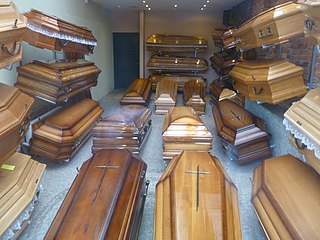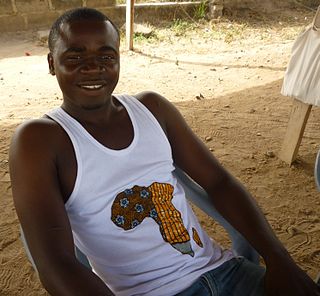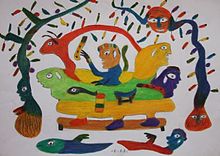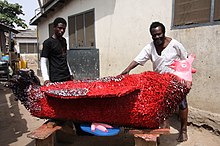
A coffin is a funerary box used for viewing or keeping a corpse, either for burial or cremation.

Ghana is a country of 28.21 million people and many native groups, such as:
The Akan people are a Kwa group living primarily in present-day Ghana and in parts of Ivory Coast and Togo in West Africa. The Akan speak dialects within the Central Tano branch of the Potou–Tano subfamily of the Niger–Congo family. Subgroups of the Akan people include: the Agona, Akuapem, Akwamu, Akyem, Anyi, Ashanti, Baoulé, Bono, Chakosi, Fante, Kwahu, Sefwi, Wassa, Ahanta, and Nzema, among others. The Akan subgroups all have cultural attributes in common; most notably the tracing of matrilineal descent in the inheritance of property, and for succession to high political office.
The Ga-Dangbe, Ga-Dangme, Ga-Adangme or GaDangme are an ethnic group in Ghana, Togo and Benin. The Ga and Dangbe people are grouped respectively as part of the Ga–Dangme ethnolinguistic group. The Ga-Dangmes are one ethnic group that lives primarily in the Greater Accra region of Ghana. Ethnic Ga family names (surnames) include Nikoi, Amon, Kotey, Kotei, Adei, Kutorkor, Oblitey, Lartey, Nortey, Aryee, Obodai, Oboshi, Torgbor, Torshii and Lante. The following are names derived from the ethnic Dangme and common among the Ningos Nartey, Tetteh, Kwei, Kweinor, Kwetey, Narteh, Narh, Dugbatey, Teye, Martey, Addo, Siaw, Saki, Amanor, Djangba. These are aligned to the ethnic Ga as well: Lomotey, Tetteh, Ankrah, Tetteyfio, Laryea, Ayitey, Okai, Bortey, Quaye, Quaynor, Ashong, Kotei, Sowah, Odoi, Ablor, Adjetey, Dodoo, Darku and Quartey.

The litter is a class of wheelless vehicles, a type of human-powered transport, for the transport of people. Smaller litters may take the form of open chairs or beds carried by two or more carriers, some being enclosed for protection from the elements. Larger litters, for example those of the Chinese emperors, may resemble small rooms upon a platform borne upon the shoulders of a dozen or more people. To most efficiently carry a litter, porters either place the carrying poles directly upon their shoulders or use a yoke to transfer the load from the carrying poles to the shoulders.

Teshie is a coastal town in the Ledzokuku Municipal District, a district in the Greater Accra Region of southeastern Ghana. Teshie is the ninth most populous settlement in Ghana, with a population of 171,875 people.
Asamankese is a town in south Ghana and is the capital of West Akim Municipal District, a district in the Eastern Region of south Ghana. Asamankese has a 2013 settlement population of approximately 39,435 people. Asamankese is on the main highway to Kumasi and Accra in the interior. The people of Asamankese celebrate the Obuodwan festival.
Articles related to Ghana include:

The Akyem are an Akan people. The term Akyem is used to describe a group of four states: Asante Akyem, Akyem Abuakwa, Akyem Kotoku and Akyem Bosome. These nations are located primarily in the eastern region in south Ghana. The term is also used to describe the general area where the Akyem ethnic group clusters. The Akyem ethnic group make up between 3-4 percent of Ghana's population depending on how one defines the group and are very prominent in all aspects of Ghanaian life. The Akyem are a matrilineal people. The history of this ethnic group is that of brave warriors who managed to create a thriving often influential and relatively independent state within modern-day Ghana. When one talks of Ghanaian history, there is often mention of The Big Six. These were six individuals who played a big role in the independence of Ghana. Of the big six, people of Akyem descent made up the majority.
Akwamu was a state set up by the Akwamu people in present-day Ghana. After migrating from Bono state, the Akan founders of Akwamu settled in Twifo-Heman. The Akwamu led an expansionist empire in the 17th and 18th centuries. At the peak of their empire, Akwamu extended 400 kilometres (250 mi) along the coast from Ouidah, Benin in the East to Winneba, Ghana in the West.
Owusu-Ankomah is a leading contemporary African artist with origins in Ghana. His work addresses themes of identity and the body, using his trademark motif of Adinkra symbolism. His work is also "influenced by the art of the Renaissance, handwritten texts from ancient cultures such as the adinkra symbol system of the Akan people of Ghana, Chinese ideograms, and contemporary global cultures." Owusu-Ankomah is a trained artist from Achimota college, near Accra, "established in 1936 and in 1952 incorporated into the University of Science and Technology at Kumasi."

Eric Adjetey Anang is a Ghanaian sculptor and fantasy coffin carpenter. He was born in Teshie, Ghana and runs the Kane Kwei Carpentry Workshop. He currently maintains dual residency and splits his time between Ghana and Madison, Wisconsin, where he is pursuing unique projects.

The Kane Kwei Carpentry Workshop is a studio established in Teshie, Ghana, since the 1950s. It is known for its design coffins that became symbolic of African artistic creativity. It featured the talents of several artists who would go on to gain fame as fantasy coffin sculptors, including Paa Joe, Kane Kwei, Eric Kwei, Cedi Kwei, and the lead of the shop at Kane Kwei's death, Theophilius Nii Anum Sowah.

Kudjoe Affutu is a Ghanaian artist and figurative coffin and palanquin builder. He was born and still lives in Awutu Bawyiase, Central Region, Ghana. Affutu has made a name for himself in Europe by participating in various art projects and exhibitions.
Regula Tschumi is a Swiss social anthropologist and art historian.

Ataa Oko Addo was a Ghanaian builder of figurative palanquins and figurative coffins, and at over 80 years of age he became a painter of Art Brut.

Fantasycoffins or figurative coffins, also called “FAVs” and custom, fantastic, or proverbial coffins, are functional coffins made by specialized carpenters in the Greater Accra Region of Ghana. These colorful objects, which developed out of figurative palanquins, are not only coffins but considered works of art. They were shown for the first time to a wider Western public in the exhibition Les Magiciens de la terre at the Musée National d'Art Moderne in Paris in 1989. The seven coffins shown in Paris were made by Kane Kwei (1922–1992) and his former assistant Paa Joe. Since then, coffins by Kane Kwei, his grandson Eric Adjetey Anang, Paa Joe, Daniel Mensah, Kudjoe Affutu, Theophilus Nii Anum Sowah, Benezate, and other artists have been displayed in international art museums and galleries around the world.
Paa Joe is a Ghanaian sculptor, and figurative palanquin and fantasy coffin carpenter. Joe is considered one of the most important Ghanaian coffin or abebuu adekai artists of his generation. He has been involved in the international art world since 1989, and has been included in major exhibitions in Europe, Japan, and the USA. His fantasy coffins are in the collections and on permanent display in many art museums worldwide, including the British Museum in London, the Brooklyn Museum in New York, the Royal Ontario Museum in Canada, the Museum of Fine Arts, Boston, the National Museum of Ethnology in Osaka and many others as well as the private collections of foreign dignitaries. Joe is building an art academy and gallery to support the community and art students across the globe.

Daniel Mensah, also known as Hello, is a Ga carpenter and fantasy coffin artist. He works as an independent artist and carpenter in Teshie, Greater Accra, Ghana.
A Ghanaian film poster is a film poster hand-painted in Ghana used to advertise films produced in Ghana as well as world cinema. Ghanaian film posters, particularly hand-painted posters from the 1980s and 1990s, have become noted for their imaginative and unique artistry. They have been exhibited around the world in galleries and museums in Los Angeles, New York, Hong Kong, San Francisco, Chicago, and across Europe.














